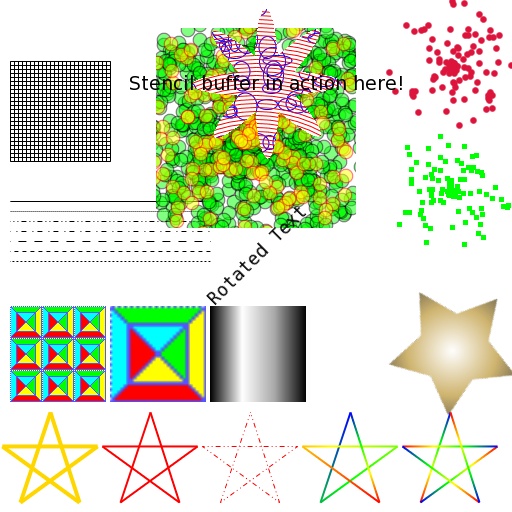This tutorial demonstrates how to perform all the most important vector graphics operations using the vl::VectorGraphics class.

[From App_VectorGraphics.cpp]
class App_VectorGraphics: public BaseDemo
{
public:
virtual void initEvent()
{
vl::Log::notify(appletInfo());
// disable trackball and ghost camera manipulator
trackball()->setEnabled(false);
ghostCameraManipulator()->setEnabled(false);
// camera setup
rendering()->as<vl::Rendering>()->camera()->setProjectionOrtho(-0.5f);
// reset view matrix to I
// load images used later as textures
// load colorful pattern & substitute black with transparent blue
pattern->substituteColorRGB_RGBA(0x000000,0x0000FFAA);
// load transparent star
// colorize the point to green and black
circle16_bg->substituteColorGreenKey(0x00FF00,0x000000);
// colorize the point to yellow and red
circle16_yr->substituteColorGreenKey(0xFFFF00,0xFF0000);
// generate the color spectrums
vl::ref<vl::Image> spectrum1 = vl::makeColorSpectrum(128, vl::blue, vl::green, vl::yellow, vl::red);
vl::ref<vl::Image> spectrum2 = vl::makeColorSpectrum(128, vl::black, vl::white, vl::gray, vl::black);
// add a new VectorGraphics to our SceneManagerVectorGraphics
vgscene->vectorGraphicObjects()->push_back(vg.get());
// start drawing with our new VectorGraphics object!
vg->startDrawing();
// clear the viewport
vg->clearColor(vl::white);
// ###### textured quad rendering ######
// this way the texels are perfectly centered on the pixels
vg->translate(-0.5f,-0.5f);
vg->pushMatrix();
// textured quad #1 repeat texturing
vg->translate(10,110);
// textured quad #2 stretch texturing
vg->translate(100,0);
// textured quad #3 stretch texturing
vg->translate(100,0);
vg->popMatrix();
// ###### line rendering ######
vg->setLineWidth(1.0f);
vg->setColor(vl::black);
vg->resetMatrix();
vg->translate(10,250);
vg->drawLine(0,0, 200,0);
vg->translate(0,10);
vg->drawLine(0,0, 200,0);
vg->translate(0,10);
vg->drawLine(0,0, 200,0);
vg->translate(0,10);
vg->drawLine(0,0, 200,0);
vg->translate(0,10);
vg->drawLine(0,0, 200,0);
vg->translate(0,10);
vg->drawLine(0,0, 200,0);
vg->translate(0,10);
vg->drawLine(0,0, 200,0);
vg->resetMatrix();
vg->translate(10,350);
for(int x=0; x<=100; x+=4)
vg->drawLine(x,0,x,100);
for(int y=0; y<=100; y+=4)
vg->drawLine(0,y,100,y);
// ###### textured point rendering + scissor ######
// with the Scissor we can clip the rendering against a specific rectangular area
int scissor_w = 200;
int scissor_h = 200;
vg->setScissor(256-scissor_w/2,256+128-scissor_h/2,scissor_w,scissor_h);
vg->resetMatrix();
vg->translate(256,256+128);
// generate the points
std::vector<vl::dvec2> points;
for(int i=0; i<1000; ++i)
{
points.push_back(vl::dvec2(rand()%128-64,rand()%128-64));
points[i].normalize();
points[i] *= (rand()%1280) / 10.0f;
// snap to integer coordinates to avoid aliasing problems
points[i] = vl::trunc(points[i]);
}
// draw the points
vg->drawPoints(points);
points.clear();
for(int i=0; i<200; ++i)
{
points.push_back(vl::dvec2(rand()%128-64,rand()%128-64));
points[i].normalize();
points[i] *= (rand()%1280) / 10.0f;
// snap to integer coordinates to avoid aliasing problems
points[i] = vl::trunc(points[i]);
}
// draw the points
vg->drawPoints(points);
vg->removeScissor();
// ###### rounded point rendering ######
vg->setPointSize(7);
vg->setColor(vl::crimson);
vg->translate(196,64);
points.clear();
for(int i=0; i<100; ++i)
{
points.push_back(vl::dvec2(rand()%128-64,rand()%128-64));
points[i].normalize();
points[i] *= (rand()%640) / 10.0f;
// snap to integer coordinates to avoid aliasing problems
points[i] = vl::trunc(points[i]);
}
vg->drawPoints(points);
// ###### squared point rendering ######
vg->setPointSize(5);
vg->setPointSmoothing(false);
vg->setColor(vl::green);
vg->translate(0,-128);
points.clear();
for(int i=0; i<100; ++i)
{
points.push_back(vl::dvec2(rand()%128-64,rand()%128-64));
points[i].normalize();
points[i] *= (rand()%640) / 10.0f;
// snap to integer coordinates to avoid aliasing problems
points[i] = vl::trunc(points[i]);
}
vg->drawPoints(points);
// ###### stencil buffer rendering ######
// reset states
vg->resetMatrix();
vg->setColor(vl::white);
// clear the stencil buffer
vg->clearStencil(0);
// enable stencil test
vg->setStencilTestEnabled(true);
// setup stencil test: writes 0x01 on the stencil buffer when rendering polygons, lines etc.
vg->setStencilFunc(vl::FU_NOTEQUAL, 0x01, 0x01);
// ###### render the rose on the stencil buffer ######
// rose create and bind transform
mRoseTransform = new vl::Transform;
rendering()->as<vl::Rendering>()->transform()->addChild(mRoseTransform.get());
// draw our rotating rose as a set of 4 filled ellipses and bind them to mRoseTransform
vg->fillEllipse(0,0 , 150,25)->setTransform(mRoseTransform.get());
vg->pushMatrix();
vg->rotate(45);
vg->fillEllipse(0,0 , 150,25)->setTransform(mRoseTransform.get());
vg->rotate(45);
vg->fillEllipse(0,0 , 150,25)->setTransform(mRoseTransform.get());
vg->rotate(45);
vg->fillEllipse(0,0 , 150,25)->setTransform(mRoseTransform.get());
vg->popMatrix();
// ###### fill the rose with color ######
// setup stencil test: renders only where the stencil buffer is set to 0x01
vg->setStencilFunc(vl::FU_EQUAL, 0x01, 0x01);
// make sure our matrix is clean
vg->resetMatrix();
// render random blue ellipses
vg->setColor(vl::blue);
for(int i=0; i<400; ++i)
vg->drawEllipse(rand()%512,rand()%512 , rand()%20+10,rand()%20+10);
// renders concentric red circles
vg->setColor(vl::red);
for(int i=0; i<256/4; ++i)
vg->drawEllipse(256,256 , i*8,i*8);
// finish with the stencil
vg->setStencilTestEnabled(false);
// render text following our rotating rose
vg->setColor(vl::black);
// note that the 2D text is not transformed by mRoseTransform but just follows an idea point transformed by mRoseTransform.
vg->drawText("Stencil buffer in action here!", vl::AlignHCenter|vl::AlignVCenter)->setTransform(mRoseTransform.get());
// ###### draws a rotated text ######
vg->setColor(vl::black);
vg->pushMatrix();
vg->rotate(45);
vg->popMatrix();
// ###### transparent star image ######
vg->pushState();
mStarTransform = new vl::Transform;
rota_star->setTransform( mStarTransform.get() );
rendering()->as<vl::Rendering>()->transform()->addChild( mStarTransform.get() );
vg->popState();
// ###### how to instance multiple times the same object ######
// generate 5 corner star: line loop primitive
std::vector<vl::dvec2> star_line_loop;
for(int i=0; i<5; ++i)
{
// snap to integer coordinates to avoid aliasing
v = vl::trunc(v);
star_line_loop.push_back(v.xy());
}
// ###### generate 5 corner star: lines primitive ######
std::vector<vl::dvec2> star_lines;
for(int i=0; i<5; ++i)
{
// snap to integer coordinates to avoid aliasing
v1 = vl::trunc(v1);
v2 = vl::trunc(v2);
star_lines.push_back(v1.xy());
star_lines.push_back(v2.xy());
}
// star1
vg->setLineWidth(4.0f);
vg->setColor(vl::gold);
vl::Actor* star1 = vg->drawLineLoop(star_line_loop);
// star2 - recycle the geometry from star1
vg->setLineWidth(2.0f);
vg->setColor(vl::red);
vl::Actor* star2 = vg->drawActorCopy(star1);
// star3 - recycle the geometry from star1
vg->setLineWidth(1.0f);
vl::Actor* star3 = vg->drawActorCopy(star1);
// star4 - texturing #1
vg->setColor(vl::white); // make sure color is white so that the texture color is not filtered
vg->setLineWidth(2.0f);
// Here we call drawLineLoop() because we need to create a new geometry instance
// so that VL can generate appropriate UV texture coordinates that are dependent
// on the currently active Image.
vl::Actor* star4 = vg->drawLineLoop(star_line_loop);
// star5 - texturing #2
// Here we draw the star using drawLines() instead or drawLineLoop().
// Note how drawLines() and drawLineLoop() generate different texturing effects.
// render the 4 instances in 4 different points
// Since they are not animated we can setup the matrices without binding it to the Rendering's root Transform
star1->transform()->computeWorldMatrix();
star2->transform()->computeWorldMatrix();
star3->transform()->computeWorldMatrix();
star4->transform()->computeWorldMatrix();
star5->transform()->computeWorldMatrix();
vg->endDrawing();
}
virtual void updateScene()
{
mat = vl::mat4::getRotation(vl::Time::currentTime() * 5.0f, 0, 0, 1) * mat;
mat = vl::mat4::getTranslation(256,256,0) * mat;
mRoseTransform->setLocalMatrix(mat);
mat.setIdentity();
mat.rotate(vl::Time::currentTime()*60, 0,0,1);
mat.translate(256,256,0);
mStarTransform->setLocalMatrix(mat);
}
void resizeEvent(int w, int h)
{
rendering()->as<vl::Rendering>()->camera()->viewport()->setWidth(w);
rendering()->as<vl::Rendering>()->camera()->viewport()->setHeight(h);
rendering()->as<vl::Rendering>()->camera()->setProjectionOrtho(-0.5f);
}
protected:
vl::ref<vl::Transform> mRoseTransform;
vl::ref<vl::Transform> mStarTransform;
};
// Have fun!